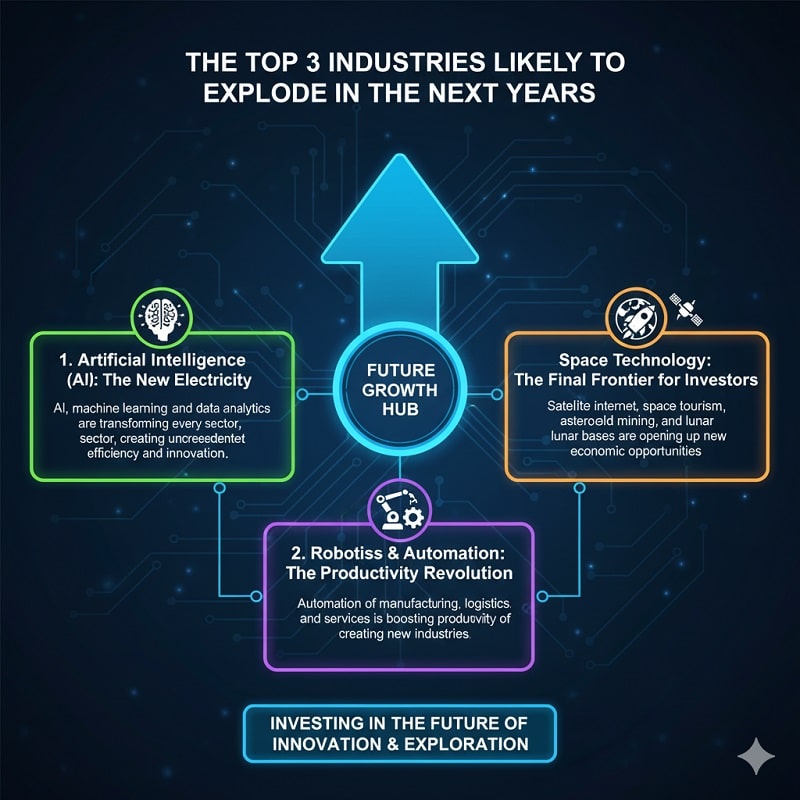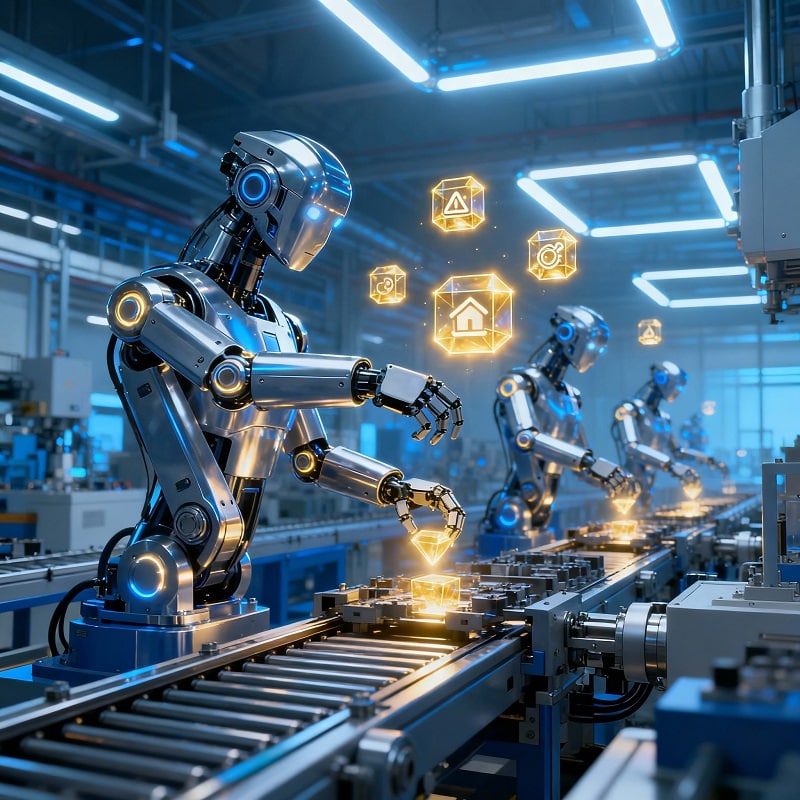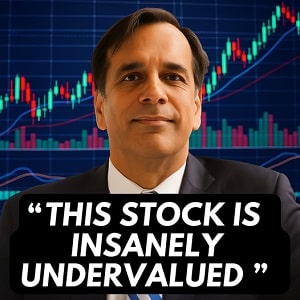From robotics to space tech, discover the industries with the biggest upside for long-term investors and how to spot these massive trends early!
Why the Next Decade Will Mint the Next Generation of Millionaires
Every decade produces its own set of breakout industries — the ones that quietly begin as niche experiments and end up reshaping the global economy.
In the 1990s, it was the internet. Few saw it coming, and fewer still believed it would redefine how humans communicate, shop, and think. In the 2000s, it was mobile computing, with Apple’s iPhone turning the tech world on its head. In the 2010s, cloud technology and electric vehicles created new titans like Tesla and reshaped industries from energy to logistics.
Now, as we move deeper into the 2020s and beyond, the next set of transformations is already unfolding. Most people won’t recognize them until it’s too late — just as most investors didn’t recognize Amazon for what it was in 2001, or Nvidia in 2014.
The real wealth, however, goes to those who do.
As someone who’s spent years studying innovation cycles and the flow of investor capital, I can tell you: we are entering one of the most powerful decades for technological expansion in modern history.
But the challenge isn’t knowing that big change is coming — it’s identifying where that change will hit hardest, which industries will multiply, and when to get in before the crowd does.
Today, we’ll break that down.
You’ll discover the three industries most likely to explode over the next ten years, why their growth is practically baked into the economic DNA of the next decade, and how smart investors are already positioning to ride the wave early.
Key Takeaways
-
Artificial Intelligence (AI) is becoming as foundational as electricity — quietly transforming every sector that touches data, decision-making, or efficiency.
-
Robotics and Automation are igniting the next productivity revolution, filling labor gaps and unlocking trillion-dollar efficiencies across manufacturing, logistics, and healthcare.
-
Space Technology is moving from government contracts to private enterprise — unleashing a new gold rush in communication, navigation, and orbital infrastructure.
-
Investors who recognize early adoption inflection points — when industries move from concept to necessity — can see outsized returns that outperform the entire market.
-
The next Amazon or Tesla will emerge from one of these industries. The question is: will you spot it early?
The New Investing Landscape: From Disruption to Acceleration
The past few years taught investors a hard truth: innovation doesn’t move in a straight line. It surges in waves — bursts of rapid growth followed by consolidation, then another surge.
Think about the late 1990s. Everyone wanted a dot-com. Then came the crash, and most investors ran for the exits. But those who looked deeper saw that the underlying technology wasn’t the problem — it was just too early. And the people who bought the survivors — Amazon, eBay, and Google — turned modest investments into fortunes.
The 2020s are shaping up the same way.
After a decade of growth in AI, green energy, and next-gen computing, the world experienced a rapid acceleration during the global lockdowns — followed by an emotional pullback.
Now, many investors are sitting on the sidelines, skeptical of what’s next.
But while they’re waiting for “certainty,” innovation is accelerating again — this time in directions that will reshape how we live, work, and interact with technology itself.
The smartest investors aren’t asking “if” these industries will boom — they’re asking “which ones will dominate first.”
Let’s start with the biggest and most undeniable force of them all.
Artificial Intelligence (AI): The New Electricity
If you think AI’s run is over, you’re missing the bigger picture.
What we’ve seen so far — chatbots, voice assistants, and language models — is just the surface layer. The true explosion in AI is coming from integration, not novelty.
Here’s what I mean:
The last five years were about building AI. The next ten are about using AI to make everything else smarter — from manufacturing to medicine.
Think of AI as the new electricity. In the early 1900s, factories were still powered by steam, even though electricity existed. It took decades for industry to rewire, redesign, and reorganize around it. Once it did, productivity surged exponentially.
That’s exactly where AI stands today.
AI’s True Wealth Creation Phase Is Just Beginning
Over the next decade, we’ll see AI move from research labs into every operational layer of the economy. The winners won’t be the companies simply talking about AI — it will be the ones quietly integrating it into their workflows, products, and data pipelines.
Key examples:
-
Logistics firms using AI to reroute global supply chains in real time.
-
Healthcare systems using predictive models to prevent diseases before symptoms appear.
-
Financial platforms using AI to detect fraud in milliseconds and price risk dynamically.
That’s where trillion-dollar efficiencies will be created.
The same thing happened with the internet. It started as a novelty — sending emails and building websites — but once it became infrastructure, entire business models were reinvented.
How AI Stocks Will Evolve Over the Next Decade
Most investors focus on the headline names — Nvidia, Microsoft, Alphabet. But real opportunity often lies just beneath the surface, in the picks and shovels — the companies enabling AI’s growth.
Those include:
-
Chip innovators designing the next wave of energy-efficient processors.
-
Data infrastructure firms managing AI’s massive bandwidth needs.
-
Automation platforms connecting AI insights to real-world decisions.
These aren’t household names yet — and that’s exactly why they represent asymmetrical upside.
Why Timing Matters
Every major technology follows a predictable curve:
-
Invention – The idea emerges (hype starts).
-
Adoption – Real-world integration begins (growth accelerates).
-
Dominance – Technology becomes indispensable (returns compound).
We’re squarely in the adoption phase of AI. The hype wave has already passed; now comes the real money phase, where companies that actually deliver results pull ahead.
This is where investors who can read patterns — and spot inflection points — will build the next generation of wealth.
Those are precisely the kinds of opportunities Jeff Brown’s research focuses on: the companies transitioning from potential to necessity.
Robotics & Automation: The Productivity Revolution
If AI is the brain, robotics is the body.
And over the next decade, we’re going to see an explosion in the use of machines that can think, learn, and act autonomously — across every industry you can name.
Think about it. Every global economy faces the same pressure:
-
Labor shortages in critical sectors.
-
Rising wages.
-
Demands for faster, more precise output.
Automation isn’t optional anymore — it’s survival.
The Economic Backbone of the Next Industrial Revolution
We’re entering what many analysts call “The Productivity Decade.” After years of underinvestment, companies are turning to robotics and automation to stay competitive.
This isn’t science fiction. It’s happening in real time:
-
Warehouses use fleets of autonomous robots to pick and pack goods with near-zero errors.
-
Construction firms use automated drones to survey land and track project progress.
-
Hospitals employ surgical robots for precision operations.
The result? Lower costs, higher output, and faster scalability.
The AI + Robotics Fusion
What makes this revolution different is the convergence between robotics and artificial intelligence. Robots are no longer static machines that follow simple instructions. They’re now learning systems that adapt to their environments.
Imagine a factory robot that reprograms itself overnight based on what it learned from production data that day.
That’s not theory — it’s happening. And every advancement in AI feeds the robotics sector like rocket fuel.
Investors who understand this overlap — between machine intelligence and mechanical automation — will be perfectly positioned for exponential returns.
That’s why Jeff Brown often calls this space “the great multiplier.” It’s where technologies converge, and the sum becomes far greater than the parts.
The Investment Angle
The robotics industry will create layers of opportunity:
-
Hardware companies building sensors, arms, and movement systems.
-
Software platforms enabling real-time coordination and control.
-
Data analytics firms connecting human oversight with machine learning.
Most of the world still sees robotics as niche or futuristic. But as with AI, the turning point comes when adoption accelerates quietly behind the scenes — and by the time headlines catch up, the early investors have already captured the upside.
The Real Lesson for Investors
Don’t look for the flashy robot names. Look for the suppliers, the engineers, the companies quietly making automation possible.
These are often small or mid-sized firms with specialized capabilities — and when demand surges, they scale fast.
In every technological revolution, the early money goes to infrastructure — not just the end product.
Robotics and automation are no different. And just like AI, this sector’s decade-long growth runway is only beginning.
Space Technology: The Final Frontier for Investors
If AI and robotics are revolutionizing the world beneath our feet, space technology is transforming everything above it.
For decades, space was the exclusive domain of governments — NASA, Roscosmos, and a handful of defense contractors. Launching a satellite cost hundreds of millions, and most missions were focused on science or surveillance.
But something profound has changed in the last decade: space has become commercial.
Thanks to a sharp decline in launch costs, a surge of private capital, and a wave of innovation in satellite design, propulsion, and materials science, space is now open for business.
We’re witnessing the birth of an entirely new economic frontier — one that will touch every part of life on Earth, from communication and defense to weather forecasting and logistics.
And investors who position early could see returns that echo the early internet boom.
From Rockets to Revenue: The Real Business of Space
Most people picture rockets when they think of space investing — the spectacular launches, reusable boosters, or billionaire-branded space tourism.
But those are just the headlines. The real wealth is being built in the infrastructure and the data layer that orbits the planet.
Here’s what’s happening:
-
Thousands of satellites are being deployed to provide global internet access, real-time imaging, and navigation services.
-
These satellites generate petabytes of data — everything from crop growth to shipping routes.
-
Companies are now finding ways to monetize that data — selling insights to logistics firms, insurers, and governments.
In other words, the real business of space isn’t in the rockets. It’s in the information economy they enable.
Just as Amazon didn’t profit from selling books — it profited from building the infrastructure for e-commerce — today’s space winners will come from firms turning orbital data into everyday utility.
The Space Economy Is Already Expanding
Look at how the numbers are trending:
-
Global space revenues have more than tripled over the past 20 years.
-
Private capital now outpaces government funding in new space ventures.
-
Entire industries — telecommunications, climate analytics, defense, and navigation — rely on orbital technology.
But we’re still early. The next ten years will bring:
-
Mega-constellations of low-Earth-orbit satellites providing real-time global connectivity.
-
Manufacturing in microgravity, producing materials and medicines impossible to make on Earth.
-
Asteroid prospecting for minerals and rare metals that could one day replace terrestrial mining.
These sound like science fiction — but so did e-commerce in 1995 or electric cars in 2008.
The difference is that, today, the cost curve has fallen enough to make all of this commercially viable.
Space + Data: The Hidden Multiplier
There’s another angle most investors miss: the space-to-Earth feedback loop.
Every satellite sends back information. That information fuels industries on the ground — logistics, agriculture, insurance, retail, even real estate.
For example:
-
Retailers track consumer traffic and behavior through satellite mapping.
-
Farmers monitor soil health and irrigation needs from orbit.
-
Insurers assess natural disaster zones without ever leaving a desk.
This “orbital data economy” is where Jeff Brown’s long-term investing philosophy truly shines — identifying industries at the edge of convergence.
He’s long argued that the real money isn’t made in the technology itself, but in the infrastructure and data layers that power it.
The space economy represents exactly that — a convergence between aerospace engineering, communications, data science, and cloud computing.
Who Will Win the Space Race 2.0?
It won’t just be the rocket companies. In fact, history shows that early infrastructure suppliers — the ones solving technical bottlenecks — often see the fastest gains.
Think of:
-
Material science firms developing heat-resistant composites.
-
Semiconductor makers designing chips for radiation-heavy environments.
-
Ground station operators handling data transmission between satellites and Earth.
Most of these firms are small- to mid-cap now — but as the industry scales, they’ll be absorbed or partnered with by global giants.
That’s how the biggest gains happen: when early innovators become essential to billion-dollar ecosystems.
The Pattern Behind All Three Industries
When you step back, AI, Robotics, and Space Tech all share one critical pattern — the same pattern that preceded every major wealth-creation cycle of the last century.
That pattern looks like this:
-
Breakthrough Innovation: A core technology changes the game.
-
Rapid Cost Decline: Barriers to entry collapse as efficiency improves.
-
Widespread Adoption: Businesses integrate it into daily operations.
-
Exponential Scale: Infrastructure becomes indispensable.
-
Industry Consolidation: The strongest players dominate, and valuations skyrocket.
That’s what happened with electricity, cars, computers, the internet, and mobile phones.
Now it’s happening again — only this time, it’s happening across multiple industries simultaneously.
AI, robotics, and space technology are reinforcing one another. AI makes robotics smarter. Robotics applies AI in the physical world. Satellites and data networks connect everything globally.
The result? A compounding loop of innovation — what some economists now call the Fourth Industrial Revolution.
Investor Psychology: Why Most People Miss the Next Big Thing
Here’s a pattern you’ll see in every cycle of innovation:
-
At first, new technologies are mocked.
-
Then, they’re hyped.
-
Then, they’re dismissed after an early crash.
-
Then, quietly, they change the world.
Investors who sell during stage three miss the payoff that comes in stage four.
That’s why so many people missed Amazon in 2002, or Tesla in 2013, or Nvidia in 2015. They saw volatility and called it “the end of the trend.”
But volatility in emerging sectors isn’t a warning sign — it’s the price of admission for exponential returns.
As an investor, your edge isn’t prediction — it’s pattern recognition. It’s knowing when a pullback is simply a pause in a long-term uptrend.
And that’s where Jeff Brown’s Near Future Report excels: distilling decades of technological research into actionable signals that tell you which industries have crossed from speculation into necessity.
The Framework for Spotting the Next Amazon or Tesla
So how do you identify these breakthrough industries early — before everyone else does?
Here are the traits I look for (and the same principles Jeff Brown uses in his analysis):
-
Exponential Cost Decline
-
When a new technology gets 10x cheaper, adoption explodes. Think of solar panels, semiconductors, or DNA sequencing.
-
-
Massive Market Disruption
-
It’s not about small improvements. It’s about replacing old systems entirely.
-
-
Cross-Sector Adoption
-
AI isn’t just for tech — it’s for healthcare, energy, manufacturing. The more industries a technology touches, the greater its multiplier effect.
-
-
Regulatory Tailwinds
-
Governments eventually follow innovation with policy support. That’s when exponential growth becomes mainstream.
-
-
Data Flywheel
-
The most powerful companies don’t just build products — they build ecosystems that improve with every user, like Amazon’s marketplace or Tesla’s self-driving data loop.
-
AI, Robotics, and Space each hit all five markers. That’s why they aren’t just “hot sectors” — they’re multi-decade compounding machines.
“Aren’t These Areas Too Risky or Overhyped?”
It’s fair to be cautious. These are cutting-edge fields, and not every player will survive.
But that’s exactly why research matters.
The goal isn’t to buy hype — it’s to identify which technologies have passed the commercial viability threshold.
Remember:
-
In 2000, 90% of dot-coms failed — but the 10% that survived changed the world.
-
In 2008, few believed electric cars would work — now the entire auto industry is pivoting.
What separates winners from losers isn’t luck. It’s understanding timing, infrastructure, and scalability.
That’s where expert analysis gives you an edge. You don’t have to chase every new stock — you just need exposure to the right industries at the right time.
That’s exactly the philosophy behind Jeff Brown’s work — helping investors cut through the noise to find the small-cap innovators and mid-stage disrupters positioned before mass adoption hits.
Action Steps for Long-Term Investors
Here’s how to practically apply these insights:
-
Allocate a Future Portfolio Slice
Dedicate 10–15% of your long-term portfolio to emerging industries. Think of it as your “innovation allocation.” -
Diversify Within Megatrends
Instead of betting on a single AI stock or one space company, build a basket across AI infrastructure, robotics software, and space data. -
Use Scaling Entry Points
Buy partial positions during periods of volatility — it’s how professionals average into innovation sectors. -
Monitor Adoption Metrics, Not Hype
Track real business integration — partnerships, production scaling, and enterprise usage — not just press releases. -
Stay Informed by Specialists
Independent researchers like Jeff Brown focus on spotting adoption inflection points — the moment innovation turns into mass necessity.
That’s when returns accelerate.
Why Timing the Next Decade Matters
The 2030s will look as different from today as today looks from the 1990s.
AI will be embedded in every workflow. Robots will handle jobs we haven’t even defined yet. Satellites will power a global data grid that connects every corner of the planet.
By the time mainstream media catches up, these industries will already be household names — and their early investors will be sitting on generational gains.
That’s why now, not later, is the time to start paying attention.
As Jeff Brown often says:
“The best opportunities don’t announce themselves. They hide in plain sight — until the world realizes what just happened.”
More About The Near Future Report
If you want to see where the biggest early-mover opportunities exist right now — in AI, robotics, and beyond — there are analysts who dedicate their entire careers to tracking these trends.
Jeff Brown’s Near Future Report is one of those resources. It’s built for long-term investors who want to understand the technologies shaping the next decade — and identify the companies quietly building the future before Wall Street catches on.
It’s not about guessing trends. It’s about connecting data, timing, and technology cycles — and translating them into clear, actionable opportunities.
That’s what separates those who read about innovation from those who profit from it.
FAQ: Future Industries & Long-Term Investing
What industries will dominate the next 10 years?
Artificial intelligence, robotics, space technology, renewable energy, and biotechnology will shape the next decade of growth — with AI and robotics leading the pack.
Are emerging industries too risky for individual investors?
They can be volatile in the short term, but properly diversified exposure — guided by research and time-tested analysis — offers some of the best long-term potential in the market.
How early is too early to invest in a new technology?
The sweet spot is between proof of concept and mass adoption — when the world knows it works but hasn’t fully priced it in.
What role does government policy play in these trends?
A major one. Policy shifts often accelerate adoption — from tax incentives to infrastructure funding — and can turn slow-moving tech into mainstream necessity.
How can I stay ahead of the next big trend?
Follow research that tracks emerging tech from the inside out — not just headlines. That’s how professionals spot future giants while they’re still underpriced.
Final Thoughts
History rewards the investors who recognize inevitability early.
AI, robotics, and space aren’t speculative fads — they’re structural revolutions in how humanity works, produces, and connects.
The tools are already in motion. The adoption curve is accelerating. The data is clear.
And the next decade?
It’s shaping up to be one of the most exciting and profitable in modern investing history.
If you’re watching closely, you can already see the outlines of the next Amazon, the next Tesla — and maybe even something bigger.
Next Step: Start positioning your portfolio around the future’s strongest currents. Study the industries shaping the next generation — and follow insights from analysts who know how to separate the noise from the signal.





































